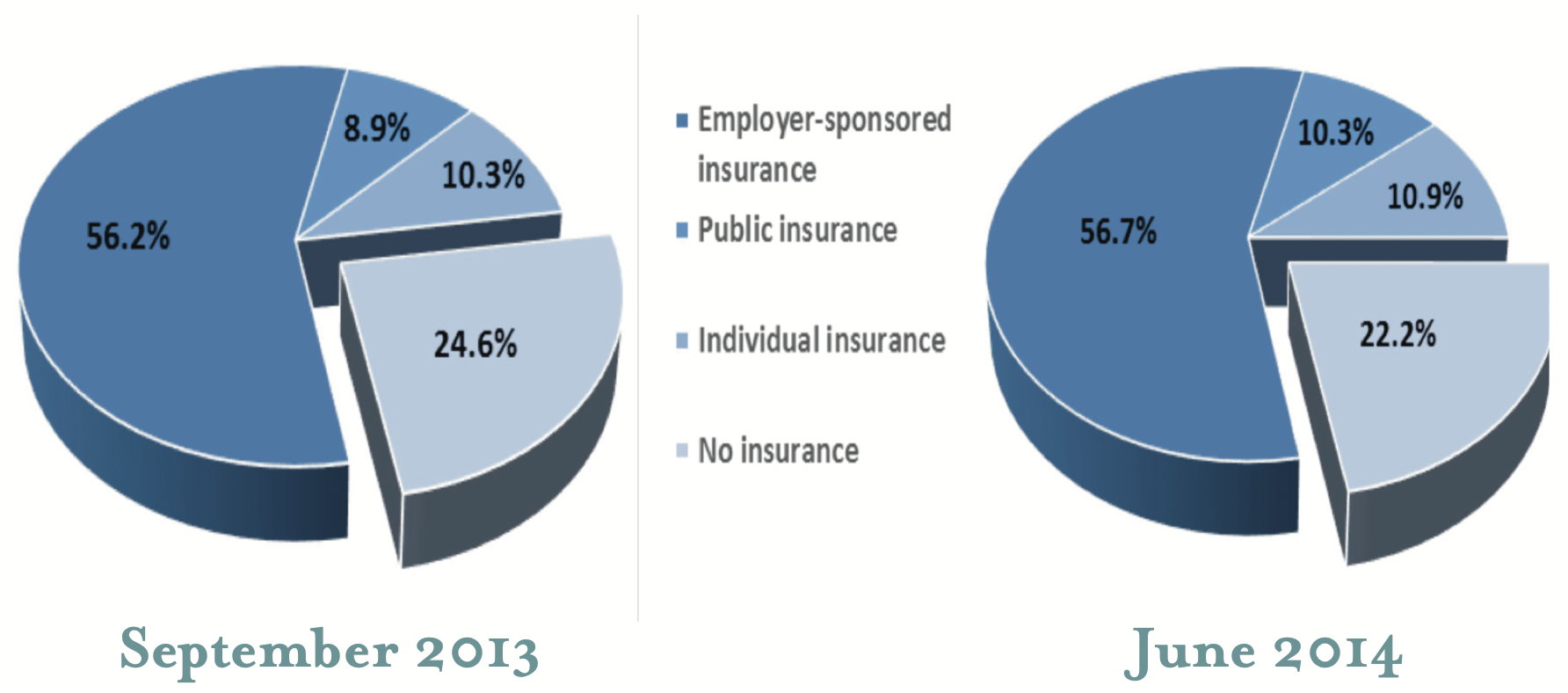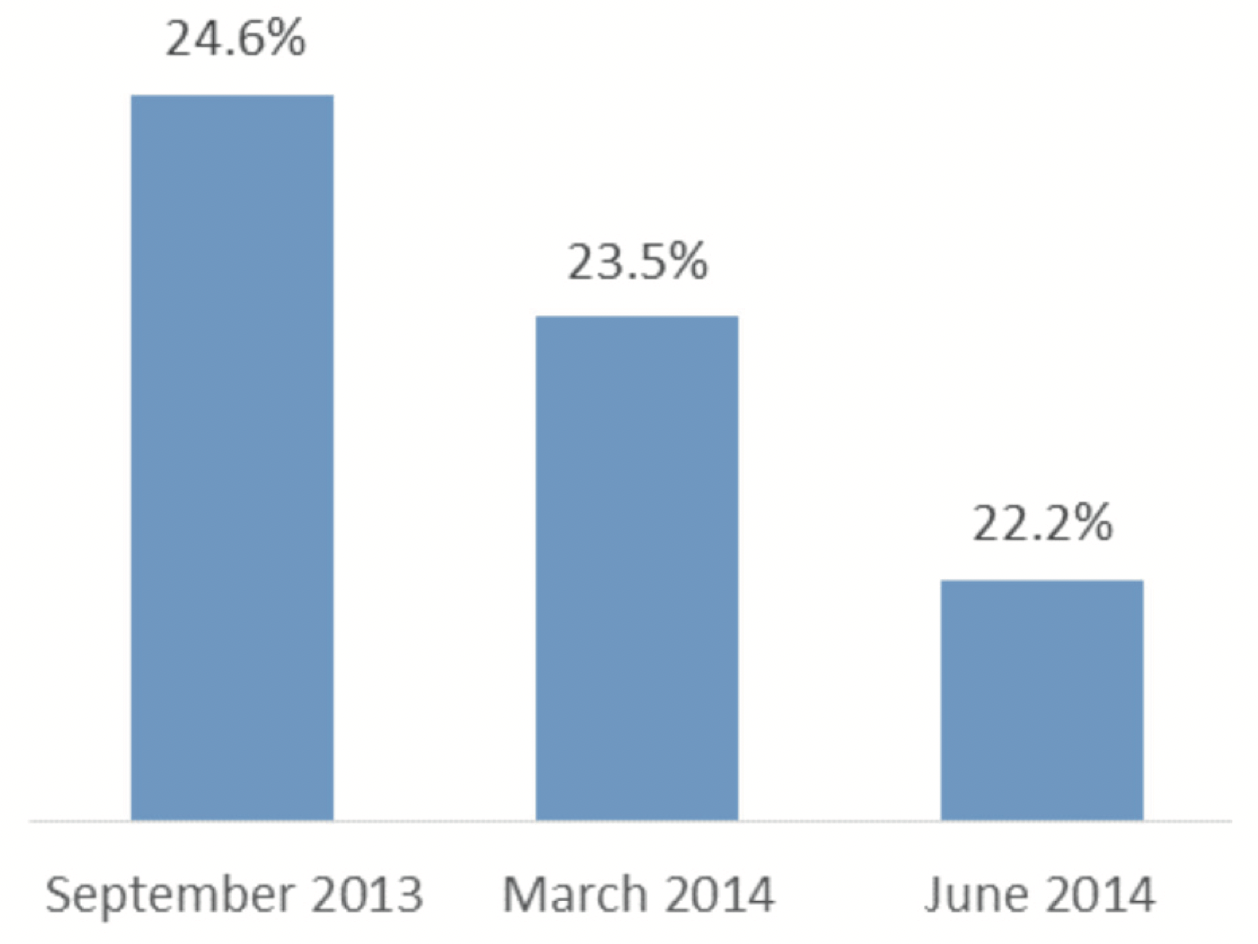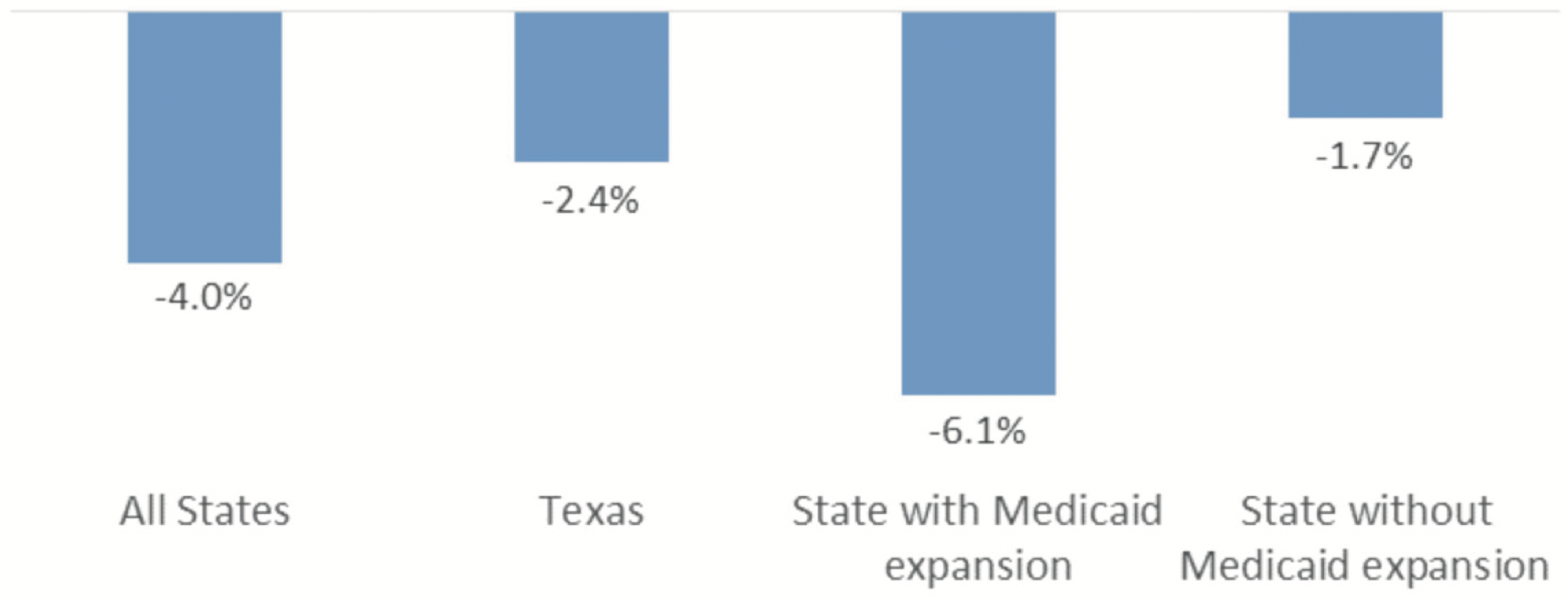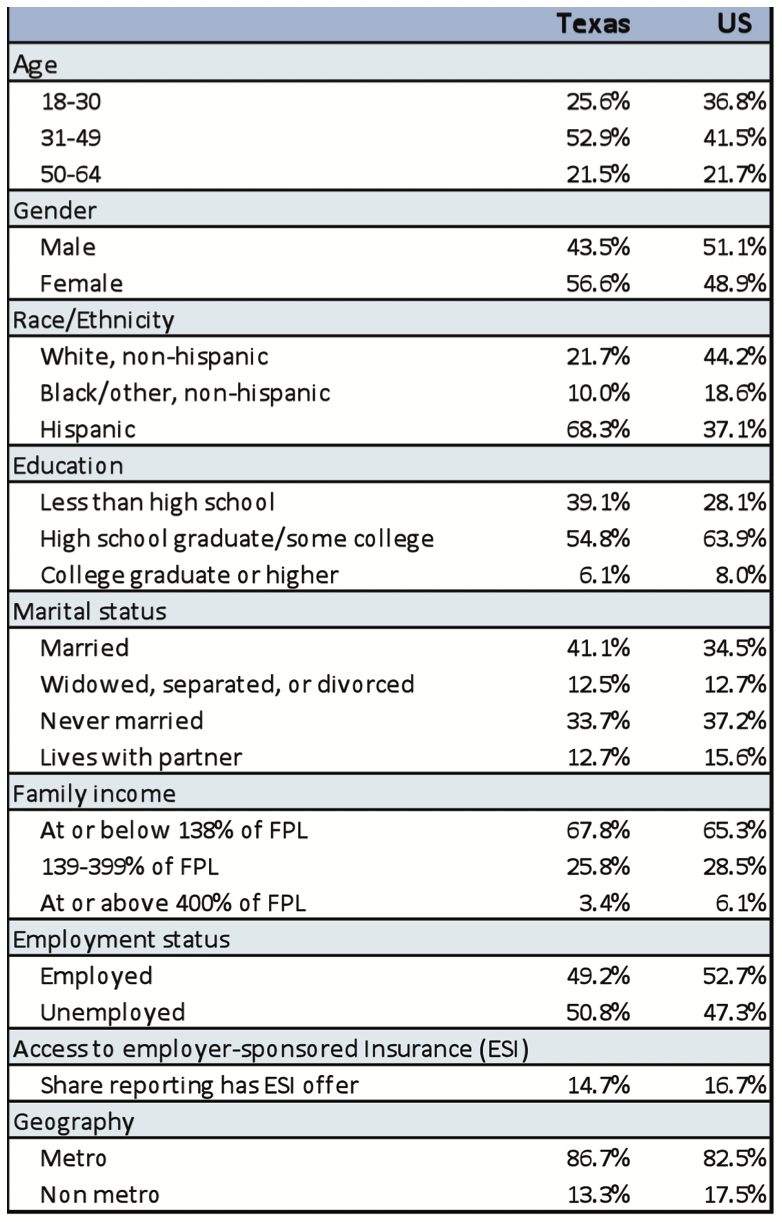HRMS Issue Brief #7: Insurance Status of Adult Texans and Characteristics of the Uninsured as of June 2014

Table of Contents
Author(s)
Elena M. Marks
Senior Fellow in Health PolicyVivian Ho
James A. Baker III Institute Chair in Health EconomicsJennifer Mineo
Health Services Research ConsultantShare this Publication
- Download PDF
- Print This Publication
- Cite This Publication Copy Citation
Marks, E. and Ho, V. James A. Baker III Institute for Public Policy, Rice University, The Episcopal Health Foundation, Health Reform Monitoring Survey – Texas, Issue Brief #7: Insurance Status of Adult Texans and Characteristics of the Uninsured as of June 2014.
In June 2014, after the completion of Health Insurance Marketplace’s first open enrollment period, we surveyed adult Texans aged 18 to 64 to examine changes in insurance status since the opening of the Marketplace and to identify the characteristics of the uninsured population. Our survey indicates that there were small gains in coverage for adult Texans from September 2013 to June 2014 and that the types of coverage did not change much when compared with pre-Marketplace coverage. Low income and Hispanic populations still comprise the majority of the uninsured, and about half are employed. Comparisons to national data show many similarities in the characteristics of the uninsured although Texas’ uninsured population tends to be more Hispanic and female and less educated than the total US uninsured adult population.
About the Survey
The Health Reform Monitoring Survey (HRMS) is a quarterly survey of adults ages 18-64 that began in 2013. It is designed to provide timely information on implementation issues under the ACA and to document changes in health insurance coverage and related health outcomes. HRMS provides quarterly data on health insurance coverage, access, use of health care, health care affordability, and self-reported health status. The HRMS was developed by the Urban Institute, conducted by GfK, and jointly funded by the Robert Wood Johnson Foundation, the Ford Foundation, and the Urban Institute. Rice University’s Baker Institute and The Episcopal Health Foundation are partnering to fund and report on key factors about Texans obtained from an expanded, representative sample of Texas residents (HRMS-Texas). The analyses and conclusions based on HRMS-Texas are those of the authors and do not represent the view of the Urban Institute, the Robert Wood Johnson Foundation or the Ford Foundation. Information about the sample demographics of the cohort is available in Issue Brief #1. This Issue Brief is a summary of data extracted from the HRMS Survey in Texas that was administered in June 2014. We will continue to report on survey data through additional Issue Briefs and future surveys..
Health Insurance Status of Pre- and Post-Marketplace Enrollment Period
In June 2014, two months after the close of the Marketplace’s open enrollment period, 77.8% of adult Texans reported that they had health coverage, a gain of 2.4% compared to September 2013. The distribution among types of coverage did not change considerably over that period of time.
Chart 1 — Insurance Status and Type of Insurance, Adult Texans, September 2013 and June 2014

The rate of respondents covered through employer sponsored plans and individual plans increased by only 0.5% and 0.6%, respectively, from September 2013 to June 2014. Although Texas did not expand its Medicaid program, the largest coverage gain was reported in public insurance. The Medicaid rolls have grown in all states, including non-expansion states, as a result of what some call the “woodwork effect” or “welcome mat.” The publicity around the ACA over the last year is credited with raising people’s interest in obtaining coverage and leading people who were previously eligible but not enrolled to enroll in Medicaid, i.e., coming out of the woodwork or responding to the welcome mat.
The percent of uninsured adult Texans decreased steadily from September 2013 through June 2014 as shown in Chart 2 below. Based on this data, we estimate that an additional 378,684 adult Texans had health insurance after the conclusion of the ACA Marketplace’s first enrollment period.
Chart 2 — Percent Uninsured Texans Aged 18-64, September 2013 Through June 2014

The 2.4% decrease in the percent of uninsured adult Texans compares favorably with other states that did not expand Medicaid for which the average decrease was only 1.7% according to national HRMS data. As Chart 3 below shows, those states that expanded Medicaid saw the biggest reductions in the percent of uninsured adults, averaging 6.1%. While the insurance gains in Texas demonstrate that people are enrolling in coverage, as the state with the highest percent of uninsured adults in the nation, Texas had the farthest to go in reducing the rate of uninsured residents. And, notwithstanding the improvement in the rate of coverage, Texas remains the state with the highest percentage of uninsured residents, and as sources indicate, has now potentially surpassed California to become the state with the highest number of uninsured residents.
Characteristics of Uninsured Adults in June 2014
Chart 3 — Percent Change in Uninsured Adults, September 2013 to June 2014

We looked at the characteristics of uninsured adult Texans as of June 2014 and compared them to those of uninsured adults across the US (estimated to be 4.9 million and 39.8 million people, respectively). As Table 1 shows, in both Texas and the US as a whole, the uninsured are primarily the young and those with lower incomes. More than two-thirds of uninsured Texans are Hispanic and only one-fifth are White in sharp contrast to the country as a whole. The Texas population is more Hispanic and less White than the US population, but the disparity between the Hispanic and White uninsured is greater than the differences in the total population. Uninsured Texans are substantially more likely to lack a high school diploma and more likely to be female than the US population.
Table 1 — Characteristics of Uninsured, Texas and U.S., June 2014

As the data show, the majority of the remaining uninsured in Texas and the US as a whole have incomes below 138% of the federal poverty level. The most likely mechanism for covering this population is through Medicaid expansion. In states like Texas that have not expanded their Medicaid eligibility, the opportunity to further reduce the percent of uninsured through the ACA is limited to the approximately one-quarter (25.8%) of uninsured adults who are eligible for subsidized Marketplace plans. In Texas, there are approximately 1.2 million adults in this category. An estimated 20% of uninsured adult Texans are undocumented and therefore unable to take advantage of Medicaid or Marketplace plans. Even if all of the undocumented were subsidy-eligible from an income standpoint, there would still be almost one million Texans eligible for Marketplace plans. This makes Texas a target rich environment for the 2014 open enrollment period. Understanding who those Texans are and how to reach them effectively will determine whether we continue to see a decline in the uninsured population.
Looking Ahead
As the nation prepares for the second year of Marketplace enrollment, our next issue brief will focus on lessons learned from those who gained coverage in 2014 to inform this year’s enrollment efforts.
Methodology
Each quarter’s HRMS sample of nonelderly adults is drawn from active KnowledgePanel® members to be representative of the US population. In the first quarter of 2013, the HRMS provided an analysis sample of about 3,000 nonelderly (age 18–64) adults. After that, the HRMS sample was expanded to provide analysis samples of roughly 7,500 nonelderly adults, with oversamples added to better track low-income adults and adults in selected state groups based on (1) the potential for gains in insurance coverage in the state under the ACA (as estimated by the Urban Institute’s microsimulation model) and (2) states of specific interest to the HRMS funders.
Although fresh samples are drawn each quarter, the same individuals may be selected for different rounds of the survey. Because each panel member has a unique identifier, it is possible to control for the overlap in samples across quarters.
For surveys based on Internet panels, the overall response rate incorporates the survey completion rate as well as the rates of panel recruitment and panel participation over time. The American Association for Public Opinion Research (AAPOR) cumulative response rate for the HRMS is the product of the panel household recruitment rate, the panel household profile rate, and the HRMS completion rate—roughly 5 percent each quarter.
While low, this response rate does not necessarily imply inaccurate estimates; a survey with a low response rate can still be representative of the sample population, although the risk of nonresponse bias is, of course, higher.
All tabulations from the HRMS are based on weighted estimates. The HRMS weights reflect the probability of sample selection from the KnowledgePanel® and post-stratification to the characteristics of nonelderly adults and children in the United States based on benchmarks from the Current Population Survey and the Pew Hispanic Center Survey. Because the KnowledgePanel® collects in-depth information on panel members, the post- stratification weights can be based on a rich set of measures, including gender, age, race/ ethnicity, education, household income, homeownership, Internet access, primary language (English/Spanish), residence in a metropolitan area, and region. Given the many potential sources of bias in survey data in general, and in data from Internet-based surveys in particular, the survey weights for the HRMS likely reduce, but do not eliminate, potential biases.
The September 2013 HRMS has a design effect of 1.47 for nonelderly adults, and a sampling margin of error for a 50 percent statistic with 95 percent confidence of +/- 1.3 for the nonelderly adult sample. The March 2014 HRMS has a design effect of .53 for a 50% statistic with a 95 percent confidence of +/- 4.0%. The design effect for the Texas data in June 2014 is 2.6198 and the MOE is +/- 4.3. The survey fielded from June 3-26.


